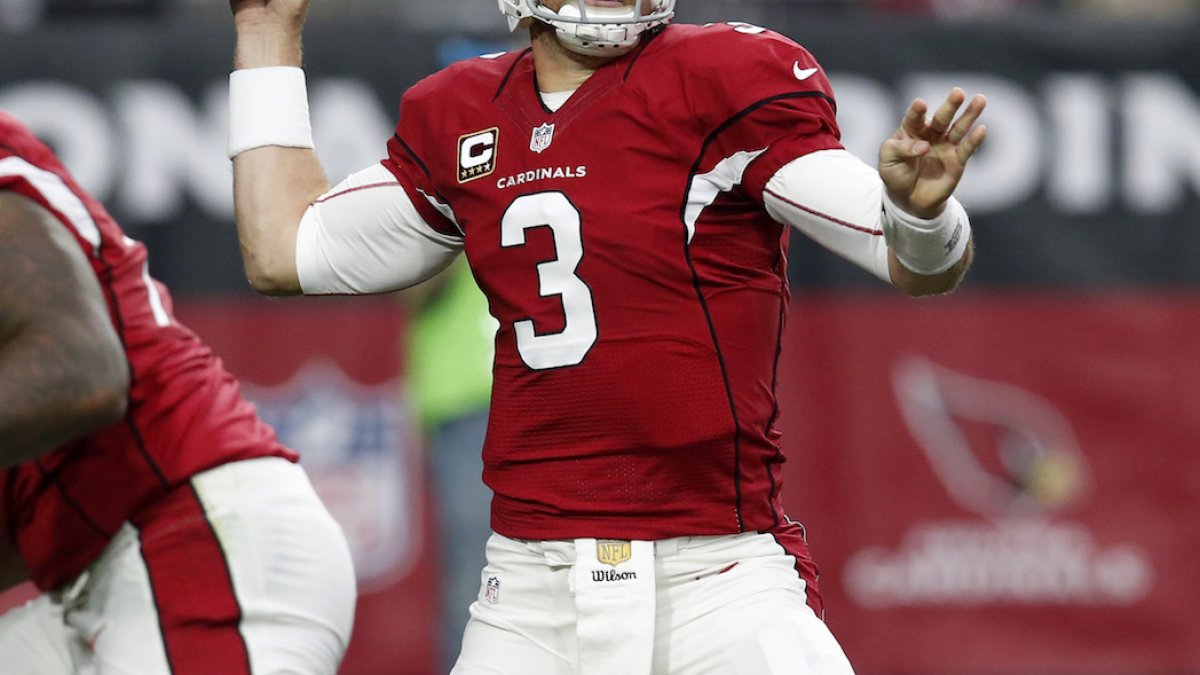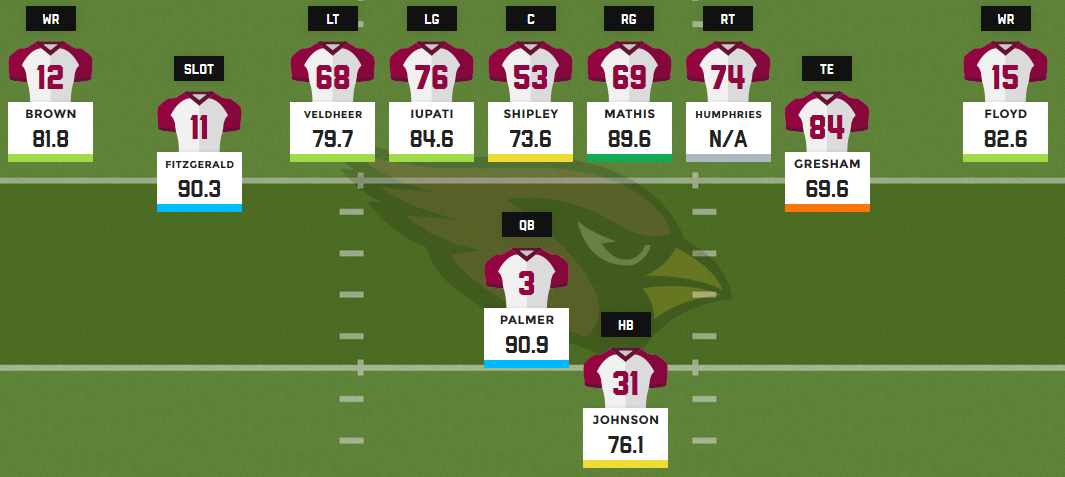(Editor’s note: As we lead up to the season, Director of PFF Fantasy Jeff Ratcliffe is breaking down each team’s depth chart from a fantasy perspective. Catch up on the work so far here.)
The star of this year’s All or Nothing, Arizona is coming off an impressive season where Bruce Arians’ team led the league in yards per game with 408.3 and were one of just two teams to top 30 points per game. This depth chart is ripe with fantasy value.
Despite being one of the league’s elder statesmen, Cardinals QB Carson Palmer is coming off of one of his best seasons as pro. The veteran signal caller posted career bests in yards (4,671) and touchdowns (35). Palmer graded out as our No. 2 quarterback, and was one of only three to post a blue-level elite grade at the position. He also led the league in yards per attempt (8.7) and average depth of throw (11.3), and was only sacked 25 times, which was second fewest among 16-game starters. Palmer finished the season as fantasy’s No. 5 quarterback, giving tremendous return on investment as the 17th quarterback selected in last year’s drafts. The Cardinals’ full complement of weapons and Arians’ aggressive downfield brand of football keeps Palmer anchored in the QB1 tier.
Arizona is one of the rare teams to have three fantasy-relevant wide receivers. Their trio of Larry Fitzgerald, Michael Floyd and John Brown are all in the WR3-or-better conversation. Fitzgerald has been a fantasy mainstay for the last decade, but is now in the twilight of his career. Last season, he got off to a hot start, posting a position-high seven touchdowns and scoring the third-most fantasy points among wide receivers over the first eight weeks. His play and productivity declined from there. Fitzgerald ranked 34th in fantasy scoring for the rest of the season. He also offered limited upside with a target more than 20 yards downfield just 8.6 percent of the time last year. While target volume could still be there, Fitzgerald’s declining play down the stretch and the fact that he’s entering his age-33 season isn’t ideal for fantasy purposes. That being said, he’s still the best bet to lead this group in targets.
Arizona Cardinals projected 2016 offense with 2015 grades:
Floyd suffered a pretty gruesome hand injury last preseason and was the least-targeted of the three over the first nine weeks of the season with just 36 targets. He sat a meager 44th in fantasy scoring among wide receivers over that span. He ranked 24th from Week 10 on and posted four 100-yard performances over his final seven games. As the Cardinals’ deep threat, Floyd was one of just 11 wide receivers to have an average depth of target over 16.0 yards last season. It’s that upside that makes Floyd appealing for fantasy purposes.
Last season, Brown saw 99 targets, which was actually 11 more than Floyd. He also topped 1,000 yards and finished 21st among wide receivers in fantasy scoring. However, over the last eight weeks of the season, Floyd saw three more targets than Brown and led all three Arizona receivers in fantasy scoring. That being said, Brown’s still has intriguing fantasy prospects. In Arians’ aggressive offense, Brown saw 27 deep targets last year. With such a large percentage of his targets coming at least 20 yards downfield, Brown screams upside. At the same time, his fantasy ceiling is capped in the WR2 range due to all of the mouths to feed in Arizona. Owning a piece of the Arizona receiver group has the potential to be very frustrating for fantasy owners this season.
J.J. Nelson is also in the mix for targets, but he’s clearly the No. 4 option. Speed makes Nelson an intriguing DFS dart, but he won’t surface on the season-long radar without an injury to one of the three starters. Darren Fells and Jermaine Gresham are the top tight end options. However, neither is worthy of fantasy consideration with so many targets going to the three starting receivers.
[So each Arizona receiver has a different level of production and a different draft value. Which has the best combination of the two? Check out our PFF Draft Master tool and try a mock draft, complete with offensive line grades, full projections and all the PFF data.]
In the wake of the Le’Veon Bell suspension, Cardinals RB David Johnson now sits atop our rankings as the No. 1 fantasy running back. Over the last month of last season, no running back scored more fantasy points than Johnson. For the season, Johnson finished fifth in fantasy points per opportunity in PPR leagues, where his ability as a receiver is especially useful. One of the most effective receivers on a per-route basis, he ranked fourth-best in yards per route run (2.12). While the Cardinals did re-sign Chris Johnson in the offseason and still have Andre Ellington, neither player is a threat to David Johnson’s workload. The veteran Johnson will spell the younger Johnson on early downs, and Ellington figures to work in on passing downs. David Johnson is in the driver’s seat in this backfield and is likely to be the first running back selected in many fantasy drafts this year.
The Cardinals are also well-stocked with fantasy assets on the defensive side of the ball. Calais Campbell finished as fantasy’s No. 11 defensive lineman last year and is a good bet to repeat as a DL1. At linebacker, Deone Bucannon will be correctly designated this year. He was one of the most productive at the position last season, and is on the fringes of the LB1 conversation. Tyrann Mathieu is recovering from a torn ACL, but he’s confident he’ll be back in action soon. If fully healthy when the season starts, Mathieu will be locked in as a DB1 option.



 © 2024 PFF - all rights reserved.
© 2024 PFF - all rights reserved.